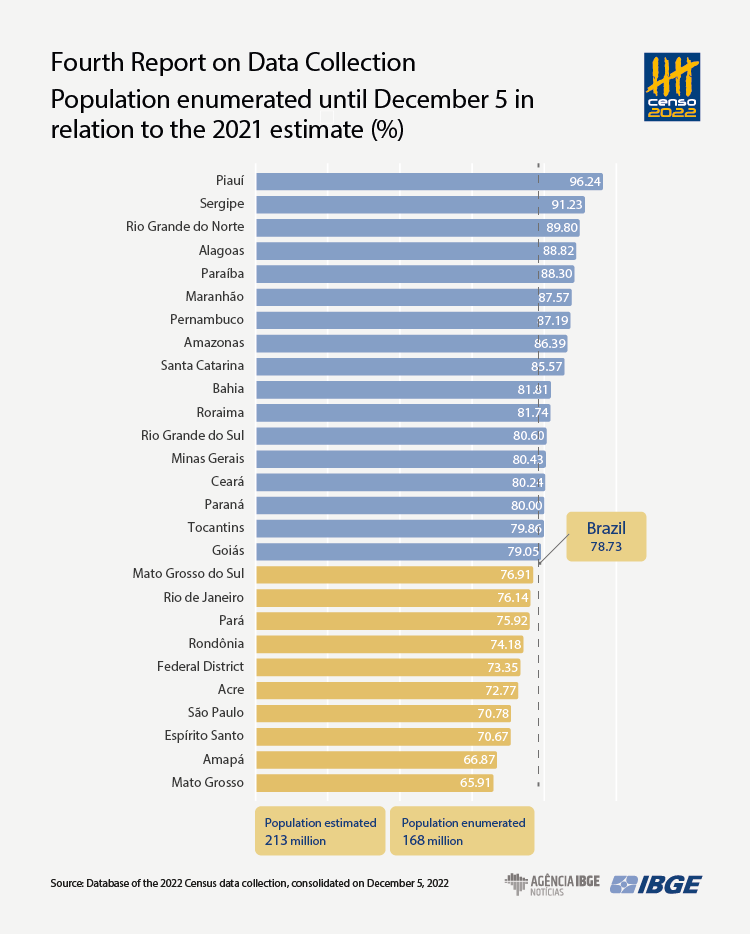Fourth report on data collection
Census counts 168 million persons, nearly 80% of the population
December 06, 2022 10h00 AM | Last Updated: December 13, 2022 02h33 PM

The IBGE is releasing today the fourth report on the 2022 Population Census data collection Since the start of the operation, on August 1st, up to December 5, 168,018,345 persons had been enumerated, in 59,192,875 housing units in the country. A total of 29.43% of these persons were in the Northeast Region; 39.54%, in the Southeast; 14.76%, in the South; 8.79%, in the North; and 7.44%, in the Central-West. So far, 48.4% of the enumerated population were men and 51.6% were women.
That total corresponds to 78.73% of the estimated Brazilian population. Piauí (96.2%) is the leader, i.e., the state with the highest proportion of persons enumerated in relation to the estimated population, followed by Sergipe (91.2%) and Rio Grande do Norte (89.8%). Mato Grosso (65.9%), Amapá (66.9%) and Espírito Santo (70.67%) are in the last positions.
“We have already finished the first step of the data collection in Sergipe and Piauí, which is the complete coverage of the state, when the addresses were visited. We are now starting to recover the housing units that were registered with missing residents and those that refused to answer the Census,” states Luciano Duarte, the Census technical manager.

Considering the 452,246 urban and rural enumeration areas in the country, 427,689 are being covered now (94.6% of the total). The most advanced state in terms of percentage of sectors covered is Piauí (99.96%), followed by Rio Grande do Norte (99.65%) and Pernambuco (99.59%). The states of Mato Grosso (84.05%), Acre (89.07%) and Roraima (90.48%) are those with the lowest percentage of sectors covered.
More than 12 million persons were enumerated in subnormal agglomerates so far
The IBGE is disclosing today, for the first time, the total population enumerated in subnormal agglomerates, defined as “irregular occupation of terrains for the purpose of living in urban areas and that, in general, are characterized by an irregular urban pattern, lack of basic public services and localization in areas restricted to occupation.” Up to the morning of December 5, 12,337,295 persons in Brazil lived in that situation, nearly 7% of the population enumerated so far.
Also, 1,489,003 indigenous persons and 1,208,702 quilombolas have already been enumerated.

Refusal rate is at 2.59%
Nearly 2.59% of the households refused to answer the census, a percentage that is expected to decrease by the end of the census operation, after all the enforcement protocols are applied.
As for the type of questionnaire, 89.4% of the housing units (52,948,134) answered the basic questionnaire and 11.6% (6,796,163), the extended one, percentages which are in accordance with the sample defined by the Institute. Five minutes has been the average length of time spent to fill out the basic questionnaire and 14 minutes, to fill out the extended questionnaire.
Most of the questionnaires (99.3%) were answered face-to-face, with 204,151 housing units having chosen to answer on the Internet and 233,894 by telephone.
Disk-Census is live in Sergipe and Piauí
The states about to complete the data collection will also count with Disk-Census, a toll-free number working from 8 AM to 9:30 PM. Those who were not visited by enumerators might call the IBGE through number 137 and require their participation in the survey. For now, the service is available only in the states of Sergipe and Piauí.
According to Duarte, whenever called, the IBGE will “check the enumeration condition of these persons and an interview will be scheduled to apply the questionnaire.”
Nearly 60.6 thousand enumerators are working, 1/3 of the positions
The Institute has been facing some difficulties resulting from lack of professionals to work as enumerators in certain areas. Between November 28 and December 4, the IBGE counted with 60,611 enumerators in the entire country, 33.1% of the positions available.
The five states behind in the evolution of the data collection - Mato Grosso, Amapá, Espírito Santo, Acre and São Paulo - have 42.1%, 35.6%, 30.3%, 40.0% and 31.9% of the active positions, respectively.
In this regard, Duarte highlights the action implemented in Rio de Janeiro: supported by the Municipal Secretariat of Health, the IBGE is training Health Community Agents to work as enumerators. “This partnership is key to complete the data collection in the capital of Rio de Janeiro,” declares him.
The enumerators will be wearing uniforms, a vest and a cap with the Census logo, an identification badge and the DMC. It is also possible to check the enumerator’s identity on the IBGE´s Answering the IBGE website or by telephone at toll-free number 0800 721 8181. Both are visible on the enumerator’s badge, which also has a QR code with a link to the website. To obtain the desired information, one has to fill in the name, enrollment number or CPF (national identification number) of the enumerator.

















